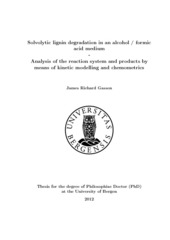| dc.contributor.author | Gasson, James Richard | eng |
| dc.date.accessioned | 2012-12-03T11:02:16Z | |
| dc.date.available | 2012-12-03T11:02:16Z | |
| dc.date.issued | 2012-10-04 | eng |
| dc.identifier.isbn | 978-82-308-2122-0 (print version) | en_US |
| dc.identifier.uri | https://hdl.handle.net/1956/6211 | |
| dc.description.abstract | Lignocellulosic biomass has been identified as an abundant renewable resource to produce sustainable alternatives for conventional fossil fuels for the transport sector as well as selected bio-materials and chemicals. Bio-ethanol production from the cellulose and hemicellulose components of this biomass type is already largely established. The remaining 20-30 % of polyphenolic residual matter could be a valueable source of revenue for lignocellulosic biorefineries. Novel fuel components and lignin derived platform chemicals, such as phenols, can be obtained by controlled depolymerisation and deoxygenation. In this thesis, a novel high temperature and pressure solvolysis of lignin-rich residual material in a formic acid / alcohol mixture has been explored. The reaction products were seen to be comprised of several substituted phenols in addition to long chained hydrocarbons, esters and ketones in a pH neutral non-viscous bio-oil. The O/C ratio was found to be so largely decreased, that a phase separation in the liquid could be observed with selected reaction parameters. In-situ generated gaseous products from formic acid are seen to enhance the lignin depolymerisation and decrease the oxygen content of the liquid products. First evaluation attempts for fuel blending were undertaken. It was found that lignin derived phenolics as the major product fraction should be concentrated upon. Other constituents were seen to be merely byproducts of other reactive components present. Several experimental series exploring reaction conditions and parameters were performed. Based upon the conclusions found from this work, the kinetics of the main reaction pathways including the deoxygenation reaction steps of monomeric phenolics were modelled. It was shown that both molecular level formation and degradation rates of various phenolics, as well as global bulks, could be correctly described by a simplified lump model. The model, which was further validated, has been shown to be applicable also at varied temperatures and for different reactor types. It will therefore form a significant basis for future scale-up work. Results showed that depolymerisation of lignin is quickly achieved and that the rate determining step of the conversion process lies within the deoxygenation reactions. These require a somewhat higher activation energy than alternative routes, the latter contributing strongly to gasification and charring reactions. Further, a new analytical data analysis method based on observed compound class variations between different analysed samples in a novel ESI-MS fingerprint approach was developed. This statistical based tool can be applied as a complement to PCA and highlights the variations based upon extraction of repetitive 14 Da spaced signals (resembling -CH2- groups) that can be used to isolate and describe the total variance of single compound classes. | en_US |
| dc.language.iso | eng | eng |
| dc.publisher | The University of Bergen | en_US |
| dc.relation.haspart | Paper A: Optimizing solvolysis conditions for integrated depolymerisation and hydrodeoxygenation of lignin to produce liquid biofuel. M. Kleinert, J.R. Gasson, and T. Barth, Journal of Analytical and Applied Pyrolysis 2009, Vol. 85, 108-117. Full-text not available in BORA. The published version of the paper is available at: <a href="http://dx.doi.org/10.1016/j.jaap.2008.09.019" target="blank"> http://dx.doi.org/10.1016/j.jaap.2008.09.019</a> | en_US |
| dc.relation.haspart | Paper B: Developing solvolytic conversion of Lignin-to-Liquid (LtL) fuel components: Optimization of quality and process factors. M. Kleinert, J.R. Gasson, I. Eide, A.-M. Hilmen and T. Barth, Cellulose Chemistry and Technology 2011, Vol. 45, No. 1-2, 3-12. Full-text not available in BORA. The published version is available at: <a href="http://www.cellulosechemtechnol.ro/pdf/CCT1-2%282011%29/p.3-12.pdf" target="blank">http://www.cellulosechemtechnol.ro/pdf/CCT1-2%282011%29/p.3-12.pdf</a> | en_US |
| dc.relation.haspart | Paper C: Lignin solvolysis: Upscaling of the Lignin-to-Liquid conversion process towards technical applicability. J.R. Gasson, M. Kleinert, T. Barth, D. Forchheim, E. Sahin, A. Kruse and I. Eide, In Proceedings of the 19th European Biomass Conference and Exhibition, 3-7 May 2010, Lyon, France, 10-13. Full-text not available in BORA. The published version of the paper is available at: <a href="http://dx.doi.org/10.5071/18thEUBCE2010-PB1.3" target="blank"> http://dx.doi.org/10.5071/18thEUBCE2010-PB1.3</a> | en_US |
| dc.relation.haspart | Paper D: Comparison of the gas hydrate plugging potentials of a set of crude oils from the Norwegian continental shelf using chemometric decomposition of GC-FID data. J.R. Gasson, T. Barth, G. Genov, Journal of Petroleum Science and Engineering 2012, Vol. 102, 66–72. Full-text not available in BORA. The published version is available at: <a href="http://dx.doi.org/10.1016/j.petrol.2013.01.010" traget="blank">http://dx.doi.org/10.1016/j.petrol.2013.01.010</a> | en_US |
| dc.relation.haspart | Paper E: Extracting homologous series from mass spectrometry data by projection on predefined vectors. J.E. Carlson, J.R. Gasson, T. Barth, I. Eide, Chemometrics and Intelligent Laboratory Systems 2012, Vol. 114, 36-43. Full-text not available in BORA. The published version of the paper is available at: <a href="http://dx.doi.org/10.1016/j.chemolab.2012.02.007" target="blank">http://dx.doi.org/10.1016/j.chemolab.2012.02.007</a> | en_US |
| dc.relation.haspart | Paper F: Modeling the lignin degradation kinetics in a ethanol / formic acid solvolysis approach - Part I: Kinetic model development. J.R. Gasson, D. Forchheim, T. Sutter, U. Horning, A. Kruse, T. Barth, Industrial & Engineering Chemistry Research 2012, 51 (32), 10595-10606. Full-text not available in BORA. The published version of the paper is available at: <a href="http://dx.doi.org/10.1021/ie301487v" target="blank">http://dx.doi.org/10.1021/ie301487v</a> | en_US |
| dc.relation.haspart | Paper G: Modeling the lignin degradation kinetics in a ethanol / formic acid solvolysis approach - Part II: Validation and transfer to variable conditions. D. Forchheim, J.R. Gasson, U. Horning, A. Kruse, T. Barth, Industrial & Engineering Chemistry Research 2012, 51 (46), 15053–15063. Full-text not available in BORA. The published version of the paper is available at: <a href="http://dx.doi.org/10.1021/ie3026407" target="blank"> http://dx.doi.org/10.1021/ie3026407</a> | en_US |
| dc.title | Solvolytic lignin degradation in an alcohol / formic acid medium - Analysis of the reaction system and products by means of kinetic modelling and chemometrics | en_US |
| dc.type | Doctoral thesis | |
| dc.rights.holder | Copyright the author. All rights reserved | en_US |
